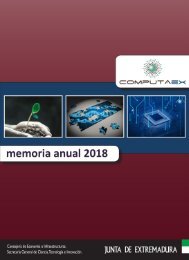Memoria COMPUTAEX 2019
Memoria Anual 2019 de la Fundación COMPUTAEX
Memoria Anual 2019 de la Fundación COMPUTAEX
Create successful ePaper yourself
Turn your PDF publications into a flip-book with our unique Google optimized e-Paper software.
CénitS - COMPUTAEX
Quantum Roaming in the Complex-Forming
Mechanism of the Reactions of OH with Formaldehyde
and Methanol at Low Temperature
and Zero Pressure: A Ring Polymer Molecular
Dynamics Approach
del Mazo-Sevillano, P., Aguado, A., Jiménez,
E., Suleimanov, Y. V., & Roncero, O.
(2019). Quantum roaming in the complexforming
mechanism of the reactions of
OH with formaldehyde and methanol at
low temperature and zero pressure: A ring
polymer molecular dynamics approach. The
journal of physical chemistry letters, 10(8),
1900-1907. doi:10.1021/acs.jpclett.9b00555
The quantum dynamics of the title reactions
are studied using the ring polymer molecular
dynamics (RPMD) method from 20 to 1200
K using recently proposed full dimensional
potential energy surfaces which include longrange
dipole–dipole interactions.
A V-shaped dependence of the reaction rate
constants is found with a minimum at 200–
300 K, in rather good agreement with the
current experimental data. For temperatures
above 300 K the reaction proceeds following
a direct H-abstraction mechanism. However,
below 100 K the reaction proceeds via
organic-molecule···OH collision complexes,
with very long lifetimes, longer than 10 –7 s,
associated with quantum roaming arising from
the inclusion of quantum effects by the use of
RPMD.
The long lifetimes of these complexes are
comparable to the time scale of the tunnelling
to form reaction products. These complexes
are formed at zero pressure because of
quantum effects and not only at high pressure
as suggested by transition state theory (TST)
calculations for OH + methanol and other OH
reactions.
The zero-pressure rate constants reproduce
quite well measured ones below 200 K, and
this agreement opens the question of how
important the pressure effects on the reaction
rate constants are, as implied in TST-like
formalisms. The zero-pressure mechanism
is applicable only to very low gas density
environments, such as the interstellar medium,
which are not repeatable by experiments.
SR-DMM: A SDN-Based DMM Solution For
Future Mobile Networks
J. Mendoza-Rubio, J. Carmona-Murillo,
J. González-Sánchez, J. Calle-Cancho
and D. Cortés-Polo, “SR-DMM: A SDN-
Based DMM Solution For Future Mobile
Networks,” in IEEE Latin America
Transactions, vol. 17, no. 05, pp. 734-741,
May 2019, doi: 10.1109/TLA.2019.8891941.
The exponential growth in the number of
mobile subscribers, as well as the data traffic
generated by them is showing a major challenge
in wireless Internet. Existing mobile networks
are starting to be insufficient in meeting this
demand, in part due to their inflexible and
expensive equipment as well as complex and
non-agile control plane. In this context, in
which the heterogeneity on the access is even
more extended, the mobility support becomes
more crucial. Thus, the mobility management
mechanisms need to evolve to fit with the
cutting-edge technologies that are going to
rule next generation mobile networks. A key
enabler to 5G will be SDN (Software-Defined
Networking), which brings a natural solution
to decouple the network control plane from
the data plane, allowing higher flexibility and
programmability to the network. Based on
SDN and following the recommendations of
the DMM (Distributed Mobility Management)
approach, this article presents the SR-DMM
solution (SDN Redirection DMM), a mobility
management mechanism that takes full
advantages of the softwarization capabilities of
the network.
This proposal avoids the use of IP-IP tunnels
and it adds the dynamic flow management
capability provided by SDN. In order to
analyse the performance of SR-DMM, an
analytical model is developed to compare it
with NB-DMM (Network-based DMM), one
of the main DMM solutions. Additionally,
SR-DMM performance is also evaluated with
an experimental testbed. The results allow to
measure the handover latency in real scenarios
and numerical investigations, also shows that
SR-DMM achieves better efficiency in terms
of signalling and routing cost than NB-DMM
solution.
53



